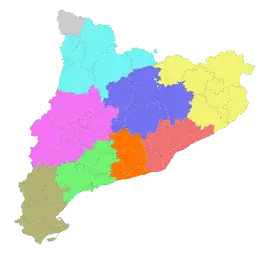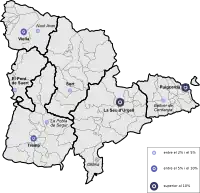Alt Pirineu
Alt Pirineu (English: Upper Pyrenees) is one of the eight regions (vegueries) defined by the Regional Plan of Catalonia. Located in the north-west of Catalonia, specifically by the Pyrenees, it covers the higher mountain regions from the Aragon border to Cerdanya. It is the least populated region, with 63,892 inhabitants as of 2022.[1]

The region includes the comarques of Alta Ribagorça, Alt Urgell, Cerdanya, Pallars Jussà and Pallars Sobirà. Although the Aran Valley is officially not part of the region,[2] it is sometimes included under the name of Alt Pirineu i Aran (English: Upper Pyrenees and Aran; Aranese: Naut Pirenèu e Aran).[3] Within Catalonia, it borders to the south with Ponent and Central Catalonia, and to the east with the Girona region.
Its de facto capital is La Seu d'Urgell, the most populous city, as a law has not set one yet.[4]
Demography

| Comarques | Population
(2022)[1] |
Area
(km²) |
|---|---|---|
| Alta Ribagorça | 3,993 | 426.68 |
| Alt Urgell | 20,237 | 1,446.53 |
| Cerdanya | 19,335 | 547.00 |
| Pallars Jussà | 13,137 | 1,339.07 |
| Pallars Sobirà | 7,190 | 1,440.14 |
Geography
Location
The location of the Upper Pyrenees is essentially strategic. It is bordered to the west by Aragon and to the north by Andorra and France's Occitania. Andorra has an significant importance in the region as, with a surface area of 8% compared to that of the region, Andorra has a population similar to the whole region. Besides, the small country has twice as many work places as the whole region, and its economy is closely tied to Andorra's. Taking advantage of this situation, the Catalan government aims to create joint Pyrenean strategies, particularly in terms of infrastructure and facilities, so that they are more favourable and can achieve sufficient critical mass to make them possible and viable.[5] Besides, the biggest city, La Seu d'Urgell, is the seat of the Bishop of Urgell, one of the co-princes of Andorra, and the region holds the Andorra–La Seu d'Urgell Airport.
Climate
The climate is predominantly mountain-based. Four zones can be distinguished: one with an alpine and subalpine climate, another with an Atlantic climate (mainly the Aran Valley), and two other ones with high-mountain and medium/low-mountain Mediterranean climates.[5]
Protected natural spaces

- Aigüestortes i Estany de Sant Maurici
- Alt Pirineu (to the north)
- Cadí-Moixeró (to the east)
The Upper Pyrenees holds a third of the protected natural areas of Catalonia. It includes a national park and two natural parks.
References
- "Idescat. Anuari estadístic de Catalunya. Població a 1 de gener. Comarques i Aran, àmbits i províncies". www.idescat.cat. Retrieved 2023-06-29.
- 324cat (2010-05-26). "La Vall d'Aran quedarà fora de la vegueria de l'Alt Pirineu". CCMA (in Catalan). Retrieved 2023-07-02.
- "La vegueria de l'Alt Pirineu i Aran rebrà una inversió de 42,3 MEUR en els pressupostos pel 2023". Govern.cat. Retrieved 2023-07-02.
- "Document". Diari Oficial de la Generalitat de Catalunya (in Catalan). Retrieved 2023-07-02.
- https://territori.gencat.cat/web/.content/home/01_departament/plans/plans_territorials/plans_territorials_parcials/aprovats/ptp_de_lalt_pirineu_i_aran/documentacio_i_planols/3_1_factorsclaudelestructuraterritorial.pdf